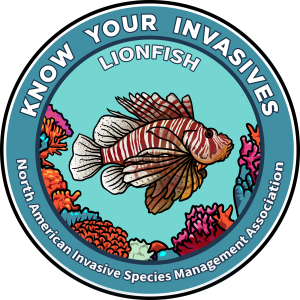Every month, new species are introduced to our lands and waters, new studies are published, and new methods of control are tested—with impacts varying across the map. It would be nearly impossible to stay on top of every piece of invasive species news.
However, the staff and board of the North American Invasive Species Management Association review headlines each month. This helps us stay on top of trends and further our mission to support, promote, and empower invasive species prevention and management in North America. We then share invasive species news most relevant for people who manage terrestrial and aquatic invasive species across the the United States, Canada and the world.
So, what happened this month?
- Fire is high on our mind, and sources are connecting severe wildfires to invasive species.
- Invasive species management tools such as biological control, pairing flooding with herbicide, and using UV light on aquatic invasives all received good coverage this month.
- In the U.S., the biggest land conservation legislation in decades will be signed, and the Department of the Interior is seeking comments on major funding for invasive species management.
- These invasive species headlines, and much more. Read on:
Success Stories: Prevention, Eradication and Restoration

Bottom left to right: Adult, eggs, larva and larval damage (see dry, dead shoot) of Archanara geminipuncta on common reed.
Invasive Weeds in America’s Western States: Restoring Balance Using Biological Control
American West — Read on CABI
Several biocontrol agents have been approved for release in the USA and there are a number of exciting biocontrol projects underway.
Interaction of Restored Hydrological Connectivity and Herbicide Suppresses Dominance of a Floodplain Invasive Species
New York — Read on New York Invasive Species Institute
Invasive species management implications include the insight that restored flood inundation onto a floodplain has the potential to reduce the dominance of perennial pepperweed over both short and long timescales. Also, “In areas where ecological function is not fully restored, the combination of applied control measures and the restored process (i.e. inundation, fire) can be successful in suppressing invasive weed populations.”
‘Fire is Medicine’: the Tribes Burning California Forests to Save Them
California — Read on The Guardian
The U.S. government outlawed the process for a century before recognizing its value.
Our 2020 Invasive Species Conference is Virtual, and We Want You to Be There!
New Research
Alien Ectomycorrhizal Plants Differ in Their Ability to Interact with Co-introduced and Native Ectomycorrhizal Fungi in Novel Sites
Global — Preview on the ISME Journal
In alien plants, successful establishment can be constrained by the absence of suitable fungal partners.
Plant Size and Habitat Traits Influence Cycad Susceptibility to Invasive Species
Guam — Read on Phys.org
Invasions included the armored scale Aulacaspis yasumatsui and specialist butterfly Chilades pandava. The results of the researchers’ island-wide compilation of plant mortality over 15 years reveals only 4% of the 2005 population remains alive on Guam. Plants within large contiguous forests have exhibited less damage than plants within forest fragments.
Detection, Management and Control
How Experts are Racing to Control the Asian Giant ‘Murder’ Hornet
Washington — Listen on WestGov
Join WGA Policy Advisor Bill Whitacre and Washington State Department of Agriculture entomologist Sven-Erik Spichiger as they explore how the Asian Giant Hornet spreads.
Tamarisk Beetles Move into Arizona

A Type of Water Chestnut, Trapa bispinoa, Threatens Potomac Watershed
Virginia — Read on WJLA
Trapa bispinoa can easily be confused with another invasive water chestnut plant already in the U.S. called Trapa natans.
Using UV Light to Treat Aquatic Invasive Species
Policy and Rulemaking
 Trump Administration Outlines Comprehensive Strategy to Tackle $120 Billion Problem
Trump Administration Outlines Comprehensive Strategy to Tackle $120 Billion Problem
United States — Read on the U.S. Department of the Interior
When finalized and implemented, the strategic plan (download PDF) will allow Interior to be a more responsive partner to state and Tribal agency requests for federal assistance to combat invasive species without adding regulations that impede business and our economy.
DOI Invasive Species Strategic Plan Public Listening Sessions
- Please RSVP by 5:00 p.m. Eastern, September 14 for sessions on September 17 or September 22 (Tribal Consultation or Alaska Native Corporation Consultation).
- RSVP by 5:00 p.m. Eastern, September 21 for sessions on September 24 or September 28 (Public Sessions).
NAISMA Request for Input
The North American Invasive Species Management Association (NAISMA) is compiling feedback from its members and subscribers and will send a summary of responses provided in this survey to DOI. Only comments that are respectful and address the Strategic Plan directly will be forwarded to DOI as public comment.
The Great American Outdoors Act: the Biggest Land Conservation Legislation in a Generation
United States — Read Q&A on Harvard Gazette
Linda Bilmes analyzes the complicated history and likely impact of the Great American Outdoors Act
Scientists’ Warning on Invasive Alien Species
Global — Read on Biological Reviews
Improved international cooperation is crucial to reduce the impacts of invasive alien species on biodiversity, ecosystem services, and human livelihoods. Countries can strengthen their biosecurity regulations to implement and enforce more effective management strategies that should also address other global changes that interact with invasions.
Conversations
Cheatgrass, Fire, and Sagebrush
Rocky Mountains – Read on Audubon
“Achieving these solutions will only be possible with widespread public demand for action, and for that to happen there needs to be a greater public awareness of the issue.”
Want more Invasive Species News? Support our work by joining NAISMA.


